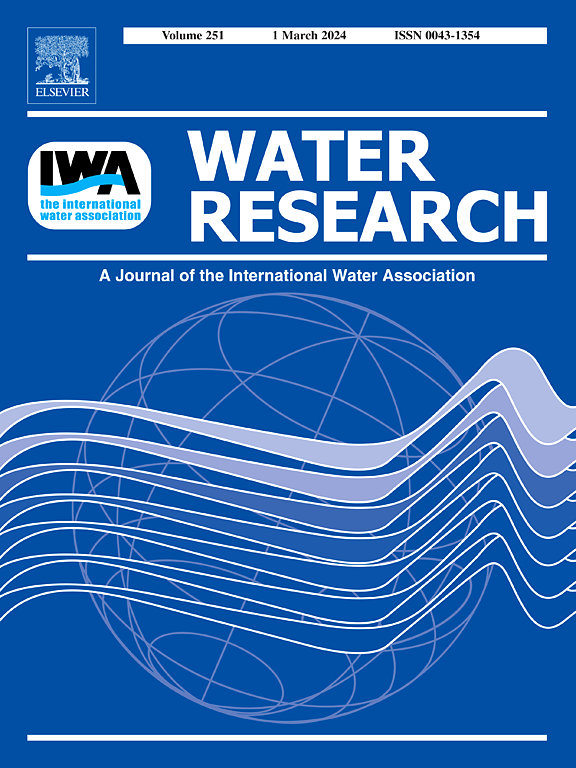通过泡沫分馏去除城市污水中的全氟和多氟烷基物质 (PFAS)
IF 11.4
1区 环境科学与生态学
Q1 ENGINEERING, ENVIRONMENTAL
引用次数: 0
摘要
与垃圾填埋场沥滤液和工业废水等其他点污染源相比,城市污水中的全氟和多氟烷基物质 (PFAS) 含量相对较低。尽管如此,它仍被视为主要的点污染源之一。之前的研究表明,泡沫分馏法能有效去除不同水基质中的 PFAS,并达到较高的 PFAS 富集度。本研究调查了从不同来源的城市污水中去除 PFAS 的情况。尽管发泡潜能较低,但全氟辛烷磺酸(PFOS)、全氟辛酸(PFOA)、全氟壬酸(PFNA)和全氟己烷磺酸(PFHxS)的平均去除率达到了 93%、利用一种新型泡沫收集方法,在不添加任何表面活性剂的情况下,21 种 PFAS 的去除率为 56%,以 PFOA 当量(ΣPFOAeq)表示的 PFAS 去除率为 91%。PFAS 的含量被降低到低于瑞典饮用水的限值和欧盟地表水的预期限值。添加四种商用表面活性剂和一种从废弃活性污泥中提取的细胞外高分子物质(EPS)都能增强泡沫的形成。此外,阳离子表面活性剂还能提高短链 PFAS 的去除率。此外,还对活性污泥进行了泡沫分馏。结果表明,ΣPFOAeq 的去除率大大降低,仅为 20%,原因是吸附在污泥中的 PFAS 比例较高。最后,该研究讨论了在城市污水处理厂应用泡沫分馏技术的实际意义。本文章由计算机程序翻译,如有差异,请以英文原文为准。

Removal of per- and polyfluoroalkyl substances (PFAS) from municipal wastewater by foam fractionation
Municipal wastewater has a relatively low content of per- and polyfluoroalkyl substances (PFAS), compared with other point sources such as landfill leachate and industrial effluents. Nevertheless, it is considered as one of the major point pollution sources. Foam fractionation was previously shown to effectively remove PFAS from different water matrices and to reach a high PFAS enrichment. In this study, the removal of PFAS from municipal wastewater of different origins was investigated. Despite the low foaming potential, it was possible to reach an average removal of the sum of perfluorooctanesulfonic acid (PFOS), perfluorooctanoic acid (PFOA), perfluorononanoic acid (PFNA), and perfluorohexanesulfonic acid (PFHxS) of 93%, the removal of the sum of 21 PFAS of 56%, and the removal of the sum of PFAS expressed as PFOA equivalents (ΣPFOAeq) of 91%, without any surfactant addition utilizing a novel approach of foam collection. The PFAS content was reduced to below the limit values for drinking water in Sweden and the anticipated future limit values for surface water in the European Union. The addition of four commercial surfactants and an extract of extracellular polymeric substances (EPS) from waste activated sludge each enhanced the foam formation. Moreover, a cationic surfactant increased the removal of short-chain PFAS. Additionally, foam fractionation of activated sludge was performed. A considerably lower ΣPFOAeq removal of only 20% was demonstrated, which was explained by a high proportion of PFAS sorbed to sludge. Finally, the study discusses the practical implications of the application of foam fractionation at municipal wastewater treatment plants.
求助全文
通过发布文献求助,成功后即可免费获取论文全文。
去求助
来源期刊

Water Research
环境科学-工程:环境
CiteScore
20.80
自引率
9.40%
发文量
1307
审稿时长
38 days
期刊介绍:
Water Research, along with its open access companion journal Water Research X, serves as a platform for publishing original research papers covering various aspects of the science and technology related to the anthropogenic water cycle, water quality, and its management worldwide. The audience targeted by the journal comprises biologists, chemical engineers, chemists, civil engineers, environmental engineers, limnologists, and microbiologists. The scope of the journal include:
•Treatment processes for water and wastewaters (municipal, agricultural, industrial, and on-site treatment), including resource recovery and residuals management;
•Urban hydrology including sewer systems, stormwater management, and green infrastructure;
•Drinking water treatment and distribution;
•Potable and non-potable water reuse;
•Sanitation, public health, and risk assessment;
•Anaerobic digestion, solid and hazardous waste management, including source characterization and the effects and control of leachates and gaseous emissions;
•Contaminants (chemical, microbial, anthropogenic particles such as nanoparticles or microplastics) and related water quality sensing, monitoring, fate, and assessment;
•Anthropogenic impacts on inland, tidal, coastal and urban waters, focusing on surface and ground waters, and point and non-point sources of pollution;
•Environmental restoration, linked to surface water, groundwater and groundwater remediation;
•Analysis of the interfaces between sediments and water, and between water and atmosphere, focusing specifically on anthropogenic impacts;
•Mathematical modelling, systems analysis, machine learning, and beneficial use of big data related to the anthropogenic water cycle;
•Socio-economic, policy, and regulations studies.
 求助内容:
求助内容: 应助结果提醒方式:
应助结果提醒方式:


